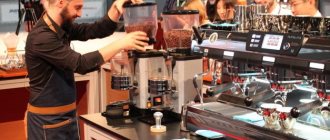Having opened his own coffee shop, every entrepreneur is faced with the need to hire staff. The first specialist needed is a barista. What skills and knowledge must a professional barista have in order for a coffee shop to operate successfully? What personal qualities should a professional have and is it worth hiring newcomers?
What should a barista know and be able to do?
Relatively recently, the term barista has appeared among new words. Literally translated from Italian, this means working behind the bar.
It is important for any coffee shop to have an experienced barista who must:
- be able to distinguish different types of coffee beans;
- know how and under what conditions coffee is grown;
- what methods are used when collecting and processing grains;
- understand the degrees of roasting;
- be able to distinguish the aromas and tastes of a drink;
- know how to store ground and bean coffee;
- be able to choose the right grind;
- prepare coffee using any equipment;
- apply various technologies and standards in preparing a coffee drink.
In addition to the ability to operate coffee machines and knowledge in the field of coffee, you need to serve the client well. The drink must be served correctly and, if necessary, the barista must be able to explain to the customer how this drink differs from others.
A professional will be able to correctly select the utensils for serving coffee, and the espresso barista can also decorate the drink by depicting any design on the foam. Not all coffee brewers have these skills.
Barista equipment
As in every profession, baristas have a lot of special equipment and special terms that are incomprehensible to the average person. To clarify and lift the veil of secrecy about making coffee, we will talk about the basic terms and techniques of a barista so that you can speak the same language with him and learn to understand it.
Coffee machine (espresso machine)
In general, everything is simple and clear here. This is a device for making espresso. The preparation process involves passing hot water of a certain temperature through a coffee tablet under a pressure of 9 bar (we are talking about traditional carob coffee machines). The coffee machine is also equipped with a steam nozzle. It is used to whip and heat milk.
Holder
The holder (portafilter holder), also known as a horn, has a portafilter (mesh) inserted into it, into which coffee grinds are poured. The holder is inserted into the group. Espresso machines come in single and multi-group types.
Temper
This is essentially a press. It is used for tempering (tamping) coffee tablets. Tampers come in different diameters depending on the diameter of the portafilter. Tempering is an important part of properly preparing espresso, so it is important that the tamper has a perfectly smooth surface, without chips or dents.
Pitcher
The container for heating and frothing milk is called a pitcher. This metal jug with a spout and a handle (some without a handle) is also used for drawing with milk, the so-called latte art is a special way of pouring milk into espresso, in which patterns are applied to the surface of the coffee.
Grinder
Grinder - everything is simple here, it’s a coffee grinder. One of the most important barista tools. The degree of grinding, its uniformity and the ability to fine-tune it all depend on the coffee grinder, so it is important not to skimp when choosing it.
How much does looks and charisma mean to a barista?
For the client, the charisma and appearance of the person serving him plays an important role. The barista must look good and be able to establish contact with the visitor. Who should act as a barista, a woman or a man? It is impossible to give a definite answer here. Male customers will be happy to see an attractive girl behind the counter, but their female companions may not like it.
If a man makes coffee, it is easier for him to carry on a conversation with a visitor, which can lead to an increase in visitors. In any case, be it a girl or a guy, they must be professionals in their field.
Requirements for a barista when hiring
When hired, a barite must be able to demonstrate his skills, namely:
- have aesthetic and artistic abilities;
- be able to make various combinations of available coffee varieties;
- have at least 40 recipes for preparing the drink, including classic options: cappuccino, espresso, Americano;
- pay attention to the equipment: put it into operation, clean it, do preventive maintenance;
- be able to work in ambiguity mode - during working hours, the barista focuses on the pressure of the coffee machine, water temperature, safety of fillers, degree of grinding, readiness of all coffee options;
- be sociable and friendly, since tips are an important factor.
Must Read: Self-Serve Coffee Shop Franchises: A Comparative Review
Making espresso
- Before inserting the holder into the group, you should run it for 2 seconds to warm up and clean the group;
- Press the pour button without delay, otherwise the coffee will burn;
- The extraction begins as soon as the button is pressed, and it is from this moment that the time must be counted, while the coffee itself can be poured after some time (2 - 5 seconds).
- You should stop pouring when the espresso stream becomes lighter and loses its texture (flows like water).
- Espresso crema disappears within 30 seconds, so it should be served within 15 seconds with a glass of water.
IMPORTANT! Making a proper, delicious cup of coffee is easy. It's hard to make 10 cups of coffee consistently well! To do this, you should monitor and control your actions, work with coffee and on equipment every time.
Is it worth hiring an inexperienced barista?
If a candidate without experience is hired, then you need to be prepared that it will take some time to train him. And then practice, which is gained in the process of work. At first, a newbie will not have high quality and speed of service. The coffee business cannot avoid this.
In the future, the employee may leave the establishment for various reasons. To prevent this, when applying for a job, you should draw up a contract and specify the conditions in it.
It should be borne in mind that young specialists are very vulnerable due to their inexperience and uncertainty, so you need to show tact and patience towards a newcomer. If his resume says stress-resistant, this does not mean that he can handle all stressful situations.
For a barista to grow into a professional, it takes the efforts of not only the beginner, but also the cafe manager and the entire team.
But, there is every chance to get your own coffee bartender, who will be trained for a specific establishment. With his eyes closed he will be able to navigate the cafe, because from the very beginning he knows where everything is. Can easily find replacements for ingredients that are temporarily unavailable. It grows and develops along with the business and forms a single whole with it.
If you don’t want to waste time training a new person, then you can hire a professional. Such a person will be able to independently adapt to the specifics of the establishment, but will find an approach to the guests. In addition, he has many ideas that can be brought to life. But here it should be remembered that such a person works as long as he is interested. Once interest wanes, the cafe may lose an employee.
Therefore, in order to retain a professional, you need to create conditions for self-improvement.
As you can see, there is no clear answer whether or not to take a newcomer to your team. Each leader makes this decision independently. However, we must remember that the main thing is not only to find a barista, but also to retain him.
Be sure to read: Coffee card in your own coffee shop: how to make it, template
How a coffee shop works: everyday life of a barista
How does a barista's day begin?
About demanding grain and personal time management
Coffee is the drink that people want to wake up with in the morning, which is why coffee shops open early. If the opening is at 8, then the barista should be at work at 7-15. In 45 minutes you need to prepare for the opening: check if everything is in order in the hall, receive and lay out desserts (they are delivered early in the morning, because traffic jams will begin later, and it will be impossible to deliver them on time), and most importantly, set up the espresso machine. If this is a modern coffee shop that works with freshly roasted specialty beans, then it takes much longer, because the taste of coffee on such beans depends on many factors.
Commercial dark roasted coffee (aka “Italian” - editor’s note), no matter how you slice it, will produce a drink with pronounced bitterness; you won’t be able to extract many shades of flavor from it. But fresh specialty grain gives both acidity and sweetness. Our task is to find a balance. To do this, you need to select the espresso “profile” - that is, find the best grinding parameters, grain setting and brewing time. How to achieve this? Make several cups, slightly changing the parameters one at a time and try. Does not work? You try again.
With good beans, everything makes a difference: two or three extra seconds of brewing can make a big difference in the taste of the drink.
There is a scale that rates the acidity, sweetness and bitterness of espresso from 0 to 5. Ideally, we would get an average rating - for example, all fours. After that, we check how the selected profile will reveal itself in milk drinks. I make a flat white - the espresso tastes stronger in it than in cappuccino.
While you are a beginner and do not know how to quickly set up a coffee machine, you do not know what is where, it is better to come even earlier, because the process will take an hour and a half. Over time, you learn to do everything automatically. Well, when everything worked out with coffee, the finishing touches remain. You check that the drink supplies are in place, put on your uniform, and your crazy day begins!
Photo: social networks of the SevBest coffee shop
How much coffee does a barista drink?
About excess caffeine and the body's reaction
Sometimes a barista drinks up to 5 cups of concentrated black coffee a day, which is physically taxing. Therefore, at some point I taught myself to have breakfast.
When I first got a job in a coffee shop with specialty beans and was undergoing training at the same time, after the shift my head was buzzing from caffeine, I couldn’t sleep, I was shaking. In such cases, bananas or a glass of beer help.
A little life hack to help your body cope with excess caffeine faster.
Evgenia Kiseleva.
What happens in a coffee shop when there are no guests?
About the work of a barista and free minutes
The work with the coffee machine does not end with the morning setup. Coffee is an organic product, it reacts to changes in climate and humidity in the room, so during the working day you adjust the settings several times. But besides this, there is always something to do in the coffee shop. As soon as the flow of guests has subsided, you wash the dishes, pour the grain into the grinder (a professional coffee grinder - editor's note), adjust the desserts in the display case, check that everything is in order in the hall, put capholders on the cups, make preparations. It happens that on some day everyone suddenly takes nut rough - which means you need to have time to chop the nuts so that there is enough for everyone. And at the end of the working day, baristas also make sure to wash the coffee machine with professional chemicals to wash away the coffee oils that have accumulated during the shift.
But if suddenly everything is perfect, but there are no visitors, you can always read special coffee literature. In your work, you don’t use all your knowledge about coffee, you forget something, and books are a great opportunity to improve your level.
Who is a chef barista?
The job of a chef barista is a different story. Ideally, he does not stand behind the counter, because even without this there is a lot to be done. In general, this is the one who is responsible for the smooth running of the coffee shop. The chef barista develops a seasonal menu, searches for and trains employees, works with suppliers and pastry chefs, and controls quality. A chef barista is a person who is always in touch and the first person to fly to if something goes wrong. You won't get bored with this kind of work!
Is the guest always right?
About communication with visitors and rudeness
I love all my guests and consider communicating with people part of my profession. A barista should not be reserved, he should say hello, be able to joke, always wish you a good day - and not limit yourself to the phrase “what will you do?” Of course, communicating with people is difficult, because you are also a person. Sometimes something happened to you, you didn’t sleep, but in the morning you still have to go to your shift and smile. Sometimes guests are rude from the door because they are not having a good day. The main thing is not to take it to heart and not to respond to rudeness with rudeness. The ability to behave with guests comes with experience.
I already understand at first glance whether a person is inclined to talk or whether it is better not to touch him.
It happens that a regular comes in with whom you chat all the time, but you can see from his mood that today he wants to sit silently on the phone. Or a reserved, uncommunicative guest suddenly comes in cheerfully and talks about his life. But my favorite cases are when a person comes in in a bad mood and leaves with a smile. So, I managed to change his day - that's very cool!
“Is there instant?”
About typical questions from guests and the mission of the coffee shop
A barista is a person who teaches people how to drink coffee. Therefore, to the questions “why does the coffee machine cost 20 rubles, and yours costs 100?” or “do you have normal instant coffee?” you calmly answer, tell what the difference is, offer to try something.
Of course, I am for guests to try coffee without syrups and sugar, because this is the only way they will feel how multifaceted the drink is. But if a person likes sweet coffee, and this is his position, I will never insist. You can get acquainted with black coffee gradually. For example, first try cappuccino with plant milk. Do you like coconut taste? Take the coconut one. It will give aroma and sweetness, but it will be a natural product, and not a sugar concentrate that interrupts the taste of the coffee itself. Over time, a person may come to love coffee without any additives.
It’s generally painful to add sugar to good specialty bean coffee, if you think about how it got into the cup. Just imagine: first, a family of farmers in distant Ethiopia or Kenya walked on foot to the highlands where coffee grows, picked it by hand under the scorching sun, sorting through each berry so that there were no defects, and took it all to the processing station. Then the beans are dried, roasted by professionals, assessed for quality, put on the market - and only after that does it end up in a coffee shop, where the barista tries to prepare it as deliciously as possible. Well, is it possible to fill this with syrup?
What do baristas dream about?
When I first started working with coffee, there was a period when it seemed to me that it was not for me. That this is boring, that it will continue to be the same thing. I even left the profession for some time. After many years, I understand how interesting this field is, which you can study throughout your life. In the future, I really want to go to a plantation, pick coffee berries with my own hands, and take part in experiments with processing - although I know that this is hellish work. Maybe I'd like to become a roaster. This is a separate area of working with coffee, which requires a long learning curve. In general, for me coffee is not a hobby or a way of earning money, it is a way of life.
This is also an opportunity to help people. Specialty coffee culture is when we track the entire production chain from sprout to cup. This means that we can find out the name of the specific farmer who grew the coffee and help his family. Thanks to what we promote in coffee shops, that same farmer can feed his children and give them an education. This is great and I want to develop this story.
Where to study
There are different ways to become a coffee bartender:
- through the barista union;
- bartenders association;
- through special accredited organizations;
- with the help of training centers from various companies specializing in the coffee and restaurant business.
You can also get an education abroad. In England there is the London School of Coffee, in America there is “roasted gossip”, etc.
Any training consists of two parts: theory and practice.
During theoretical classes, the student learns about the history of the origin of coffee, its varieties, methods of preparation, etc. More time is devoted to practice. The student learns to make different types of drinks. The training is conducted by experienced professionals and does not leave any of the students unattended. Upon completion of training, exams are passed and the new barista receives a diploma confirming that he has been assigned the appropriate qualification.
Creation of a training department
Large coffee chains usually have offices where personnel and organizational issues are resolved. In such an office, space is allocated for installing a coffee machine and coffee grinder for training new employees. After passing the interview, the employee studies in this room for several days under the guidance of a special barista trainer. Next, the new employee undergoes an internship for some time at already operating outlets. If the internship is successful, the applicant is finally hired.
In such coffee shops, high demands are placed on barista trainers, since the initial skills of all new baristas depend on their skills and ability to train.
How much pay
A barista’s income depends on his skills, the ability not only to prepare a drink, but also to serve it. At the initial stage, the salary is from 8 thousand rubles. up to 10 thousand rubles People with experience receive from 25 thousand rubles to 50 thousand rubles.
And professionals are already claiming a payment of 100 thousand rubles.
For comparison. In America, a barista earns from $8 to $12.5 per hour. This does not include tips. Together with them, the annual income can reach 18-30 thousand. In addition, when concluding a contract, the specialist is offered bonuses, health insurance and other incentives. Unscheduled work is paid at double the rate.
Working conditions
Working hours are divided into twelve-hour shifts with a schedule of two days after two or three days after three.
According to sanitary standards, all catering staff must have a health certificate. This rule also applies to baristas. Its registration costs up to 5 thousand rubles.
The work can be done either with a partner or independently. Management constantly monitors work and can arrange an inspection at any time. For violation of discipline, prescription, or appearance, a fine may be imposed.
During lunch breaks you are allowed to drink a cup of coffee, and in some establishments, eat a sandwich.











